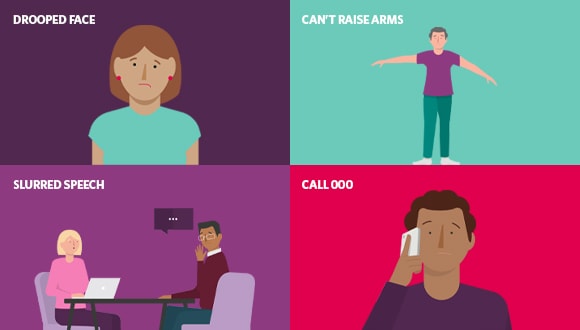What is a stroke and how could you prevent it?
Did you know that one in four of us will have a stroke during our lifetime? Learn how you could prevent a stroke, as well as recognise the signs of stroke in yourself and others.
Every 19 minutes, someone in Australia has a stroke. It kills more women than breast cancer and more men than prostate cancer, yet it doesn’t capture the media spotlight as strongly or as frequently. But it should because while stroke is a big killer, it’s often preventable and treatable.
Here’s how you could prevent a stroke and what to do if you think you or someone else might be having one.
What is a stroke?
It’s important to know what happens to your body when you have a stroke. A stroke happens when blood supply to the brain is interrupted. Blood is carried to the brain by blood vessels called arteries, bringing with it oxygen and important nutrients for your brain cells.
When a blood clot or plaque is blocking a blood vessel, it’s known as an ischaemic stroke.
When a bleed in the brain occurs, it causes a haemorrhagic stroke. Haemorrhagic strokes can be caused by a number of disorders which affect the blood vessels, including long-standing high blood pressure and cerebral aneurysms. An aneurysm is a weak or thin spot on a blood vessel wall, usually present at birth, that develops over time.
You can also have what’s known as a ‘mini’ or ‘minor’ stroke, or clinically speaking, a transient ischaemic attack (TIA). When the signs of stroke are present but go away within 24 hours, the term TIA is used. Its causes and symptoms are similar to a stroke but are unfortunately often ignored. Just like a stroke, a TIA will require emergency treatment.
After a TIA, your risk of stroke is higher, and a large part of the risk occurs in the first few days. You must not drive for two weeks after a TIA and should visit your doctor immediately, as they will likely want to carry out tests. A TIA should never be ignored and experts consider it a warning sign for stroke risk.

Can you prevent a stroke?
Professor Tim Kleinig, head of the stroke unit at Royal Adelaide Hospital’s department of neurology, says around 80% of strokes can be prevented. He says the best way to prevent a stroke is to live a healthy life.
“Eat well, keep a healthy weight, don’t smoke, exercise regularly and keep alcohol consumption to a minimum,” he explains.
“High blood pressure in particular is a key risk factor for stroke. We should all be having regular blood pressure checks, whether they be at your local pharmacy or your GP.”
The Stroke Foundation points to 2022 research that found 25 minutes of moderate to vigorous physical activity a day can significantly decrease your stroke risk, in some cases by as much as 43%. Even light physical activity helped with stroke prevention.
“Small lifestyle changes can have a big impact in reducing your stroke risk,” confirms Prof Kleinig. “These lifestyle changes will also reduce your risk of heart attack and dementia.”
If you’ve got a heart-related condition or diabetes, it’s never too late to start making positive changes. The COACH Program is a six-month phone-coaching support program provided at no extra cost for eligible members* that can help improve your health.
Other stroke risk factors
While much can be done to reduce the risk, there are some factors that are out of your control, including age (risk increases with age) and a family history of stroke.
While many people associate stroke with an older population, Prof Kleinig says it can happen to anyone. In 2020, around 24% of first-time strokes were suffered by people under the age of 54. That’s an average of around 29 strokes each day.
There are also medical risk factors, including atrial fibrillation (a cause of irregular pulse or heart palpitations), high cholesterol and diabetes. If you feel your heart beating irregularly, see your GP.

What are the signs of a stroke?
When a stroke strikes it's vital that people recognise the signs and call an ambulance quickly. “Time saved is brain saved,” says Prof Kleinig.
The Stroke Foundation offers an easy way for everyone to recognise the signs of stroke:
- Face – has the person’s face drooped?
- Arms – can the person raise both arms?
- Speech – is their speech slurred?
- Time – call 000 immediately.
The faster help arrives, the better chance a patient has of surviving.
Prof Kleinig says that as soon as a stroke attacks your brain, parts of it start to die – at a rate of up to 1.9 million brain cells a minute.
“Survival and recovery depend on fast access to treatment. The sooner a stroke is treated, the less damage it causes,” he explains.
How is a stroke treated?
Stoke treatment will depend on the type of stroke.
For an ischaemic stroke, the blood flow to the brain needs to be restored as quickly as possible. Doctors may do this through medication, removing the clot, performing a variety of surgical procedures that remove fatty plaque or to open blocked arteries.
For a haemorrhagic stroke, the bleeding and pressure on the brain needs to be controlled and reduced. This is done through a variety of surgical procedures including blood vessel repair, clipping and coiling.
Recovering from a stroke
In 2020, the Stroke Foundation estimated there were more than 445,000 people living with the effects of stroke in Australia, and expects that figure to rise to more than 819,000 by 2050.
Everyone’s recovery will be different. After a stroke, many people experience fatigue, problems with memory and organisation, speech and vision, muscle stiffness and spasms.
It’s also common to have feelings of depression or anxiety and, as a stroke can change how your body feels and works, it can affect your sex life.
Experts like neurologists, physiotherapists, occupational therapists, speech therapists and psychologists can all help, depending on the problems you face. Your GP can help find the right specialist or treatment for your symptoms.
If you’ve had a stroke, make sure to rest and pace yourself, but also try to keep as active as possible and to keep practising the things you find difficult.
The good news is that stroke survivors can continue to make improvements years later. After a stroke, the pathways in the brain can change. This means your brain may use undamaged parts of your brain to restore some of the functions impaired by a stroke. Rehabilitation therapy can be a key part of this recovery, especially in the first six months after a stroke.
Advances in prevention, diagnosis and treatment of stroke have also led to fewer lives being lost.
“Many people survive a stroke now who wouldn’t have before, and many who have had a stroke have recovered better than before, in some cases completely,” says Prof Kleinig.
You can find lots of helpful resources on the Stroke Foundation’s website.
A GP at your fingertips
We know it can be hard to manage your health in a convenient way. Our partnership with GP2U, an online video GP service, makes it easier for eligible members to access telehealth services. All HCF members with health cover can access a standard GP consultation (up to 10 minutes) for a fee of $50. See hcf.com.au/gp2u for more information.
Words by Karen Burge and Gina Flaxman
Updated August 2022
Related articles
RECOVER AT YOUR OWN PACE
There are unexpected costs to accident or illness like taxis, babysitters and extra rehab. Here’s how HCF can help with the cost of recovery.
RECOVERING FROM A STROKE
Fast, specialist treatment can be the difference between life and death. Alex Wright is living proof.
HOW TO LOWER YOUR BLOOD PRESSURE
Research shows that a couple of simple health changes could have a big impact on your blood pressure.
MY STORY: EXPERIENCING A HEART ATTACK
Healthy 56-year-old heart researcher Scott Kesteven recently suffered a heart attack. These are the warning signs he wished he’d paid attention to.
IMPORTANT INFORMATION
* To be eligible, members must have a heart-related condition or diabetes and must have had hospital cover that includes heart conditions and vascular system for at least 12 months. Excludes Ambulance Only, Accident Only Basic cover and Overseas Visitors Health Cover.
This communication contains information which is copyright to The Hospitals Contribution Fund of Australia Limited (HCF). It should not be copied, disclosed or distributed without the authority of HCF. Except as required by law, HCF does not represent, warrant and/or guarantee that this communication is free from errors, virus, interception or interference. All reasonable efforts have been taken to ensure the accuracy of material contained on this website. It’s not intended that this website be comprehensive or render advice. HCF members should rely on authoritative advice they seek from qualified practitioners in the health and medical fields as the information provided on this website is general information only and may not be suitable to individual circumstances or health needs. Please check with your health professional before making any dietary, medical or other health decisions as a result of reading this website.